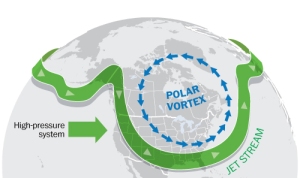There has been an interesting debate running within the Australian Institute of Company Directors ‘closed’ Linked-In group. This post is an abstract of some of the more salient points that I feel should be in the wider community. A lot of the material may be common sense, but common sense is ‘that which is commonly considered right and proper when observed’, not ‘that which anyone and everyone has already thought of’.
My view expressed in the discussion is that the managers and directors of organisations destined to fail in the next 5 to 10 years will continue to pretend the climate is not changing (the cause of the change is irrelevant). This phenomenon of refusing to accept what is gradually becoming the ‘blindingly obvious’ is not uncommon among boards – there are still people who don’t accept smoking causes disease because only 50% of long term smokers are killed by the habit and they know someone who has smoked for 40 years and is still healthy… And whilst acceptance of the lethal effects of asbestos fibres are now more widely acknowledged, the mounting evidence of the danger was ignored by boards, architects and engineers for decades preferring short-term expediency over long term risk management.
Anyone with a basic grasp of science knows it is impossible to ‘prove’ climate change in advance; predictions are always based in probability. The simple facts of science are:
Fact 1 – there is no proof of any theorem in physics – all the scientists can state is that based on observation and experiment they have not been able to disprove the concept to date. The transition from Newton’s ‘gravity’ to Einstein’s ‘relativity’ to the 98% certainty Higgs Boson has been discovered is a case in point. Climate science is no different.
Fact 2 – there is overwhelming evidence the climate is changing significantly – the immediate consequences are more severe weather events (hot and cold; eg, tornados in the Murray Valley) and sea level rises caused by the sea waters expanding as they get warmer.
Fact 3 – these changes will have inevitable consequences on every business and every organisation.
The precautionary principle suggests prudent organisations make reasonable allowances for these observed effects. Optimist may hope they are temporary and will go away in a year or two, but how many boards really what to bet their future on an optimistic hope?
WHY the climate is changing is largely irrelevant (although green house gasses seem to be a major contributor). The issue for boards is recognising the reality that exists now and dealing with the real problems this is causing today, starting with insurance cover/premiums closely followed by increasing the resilience and diversity of supply lines.
Alun Stevens suggested the science is quite settled. He posted: I grant you there is a lot of noise, but the science is settled and quite unequivocal. To put it succinctly:
- Radiation absorption by CO2 warms the atmosphere. This has been known since the mid 1800s and is identical in process to microwaves warming meat. If your microwave works, CO2 warms the atmosphere. if CO2 does not warm the atmosphere we are all deluded about our microwaves.
- Other gases including water vapour also warm the atmosphere in the same way, but more effectively.
- The higher the concentration of these gases, the greater the absorption of radiation and the greater the warming.
- The CO2 concentration is rising. Every monitoring station across the globe has shown a rise including those in Antarctica and Tasmania where there is no local production of CO2.
- The increase in CO2 is due to human activity. I can never understand why this is disputed because it is quite easy to prove. The world has an extremely accurate estimate of the amount of CO2 produced each year because of very good records of production and consumption of fossil fuels. Some may have been missed, but this just means that the answer is a Lowest estimate. The amount of CO2 in the atmosphere is a bit more difficult to measure, but is still accurately known because of the spread of measuring stations and satellites. The increase in CO2 content of the atmosphere is less than the amount produced by humans. The rest of nature is therefore a net absorber of CO2 and ALL of the increase is due to humans.
- Methane concentrations have also increased. Some from increased animal production – ie human induced. Some from land clearing and related activities – human induced. Some due to thawing of the deep frozen stores in places like Siberia. Physics interlude – ice can only melt if heat is added to it. If the methane stores are melting, their heat content is necessarily rising. The methane rise is either human produced or secondary to rising temperatures.
- Water vapour content is rising. Another physics interlude – the capacity of gases to hold water vapour is dependent on their temperature. If the water vapour content has risen it is necessarily true that the temperature of the atmosphere has also risen. Water vapour rise is a secondary effect to rising atmospheric temperatures.
- There is an energy imbalance between the energy received from the sun and the energy being radiated back into space. There is some argument about this, but only about the size of the imbalance not about its existence or that it is increasing.
- The amount of energy coming in from the sun has not changed materially. There are solar maxima and minima, but the differences in energy output between them are not big and are much too small to account for the increase in the energy imbalance. The earth has also been on a very consistent orbit over the last 150+ years or so and the Milankovitch cycle effect has in fact been very slightly negative – ie reducing the amount of incoming energy. There has been no increase in earthbound events (e.g. volcanoes) that could explain the increased imbalance. The increase is due to retaining more heat which can only be due to the ‘greenhouse’ gases.
- The energy content of the globe is increasing. Less than 2.5% of this in the atmosphere. Over 90% is in the oceans with the rest in the continents (warmer rocks) and melting ice. There has been a significant reduction in ice volume. The only scientific argument is whether it is a lot or a lot more or even still more. Sea levels have risen. Some is due to the melting of continental ice (melting sea ice doesn’t change sea levels) and the bulk from expansion due to rising sea temperatures.
He continued: Although I am now an actuary, I started out as a physicist and have been interested in climate science for 40 years. Back then the question was whether rising aerosols in the atmosphere would cause global cooling or rising CO2 would cause global warming. The world responded strongly to the rising aerosols – sulphur, ash etc – so that concern disappeared. It did not respond to CO2 and we are now where we are.
The science was actually settled 20 years ago. All that has happened in the last 20 years is to settle it more and more accurately and to falsify all competing hypotheses. (As Pat rightly points out, that is what scientists do – falsify claims. Those that remain unfalsified, no matter how unpalatable, are the best estimate of the truth available.)
The outworking of all this is that the science is clear that:
- The earth is warming.
- The warming is accelerating.
- The warming and its acceleration is caused by CO2 and its increase.
- Human activity is the source of the increasing CO2.
Having got that off my chest, we now get back to what are actually the real issues, namely what does this mean and what should we do? Here there is some room for debate and argument. What is the likely extent of the warming? How quickly will it happen? What will be the impacts on the climate and weather at different temperature levels? What will be the impact on sea levels? What impact will weather and temperature changes and sea level changes have on human and other life and their activities?
The answers to these questions go to answering the sorts of questions that directors need to be asking. What should we do? How quickly must we do it? How much should we spend? Can we afford to do nothing?
This gets down to one of my current areas of interest – risk management. Boards have a responsibility to manage risks. It is one of their primary functions. Climate risks, like all other risks require a proper approach:
- What is the risk?
- What will be the impact of the risk?
- How likely is it to happen – in this case the question is more one of when rather than if?
- Can we absorb the outcomes?
- If not, how do we mitigate the risk, insure the risk or avoid the risk?
- How do we implement our decisions?
This all requires proper forward estimations which brings me to my final question (at last). How will you make quality estimations and therefore decisions? Will you just rely on the gut feel experiential approach of, ‘don’t worry, my experience shows that nothing has happened in my lifetime or that of my father and grandfather; things are always up and down; so nothing will change’? Or will you take into account the best scientific knowledge and properly model the potential outcomes?
To answer one of my questions – we cannot afford to do nothing. We have to manage the risk.
Alun concluded: I am a great believer that change is ALWAYS an opportunity to be exploited. This is a big change and it will be worth a very serious amount of money. There are opportunities in changing what we do now to prevent or reduce the impact of climate change. And, because of the tardiness out there, there are opportunities in doing new things to cope with and exploit the changes that will happen.
Interestingly this is not a global left/right political argument. Whilst the approach adopted by Tony Abbot in his announcements this week (Australian Liberal) and the US Republican party favour the easy option – shoot the messenger, treat each occurrence of an unusual weather event as a 1 off anomaly and pretend nothing serious is happening this is not a consistent ‘right wing’ position.
The UK Conservative party has a 100% commitment to reducing greenhouse gasses enshrined in law – the Prime Minister who set this objective in motion was Margaret Thatcher, hardly a ‘left leaning green’, but she was a trained scientist.
Conversely, many labour organisations oppose change to mitigate greenhouse gas omissions because of their short-term effect on their member’s employment. And the thing I find strangest is the farming community (at least in Australia) that has to adapt fastest and will suffer the most from extreme weather events, seems to be represented by bodies that want to deny the existence of a problem.
Somewhere there is a serious communication breakdown. Our innate biases tend to mitigate against dealing with the issue; some of the more potent include:
A reluctance to do things now for an uncertain future benefit,
A preference for what we know though direct experience compared to things we cannot see or touch, and
A tendency to ignore things we don’t like or that don’t fit comfortably with our current views (see more on ‘bias’).
Education in the broadest sense is the antidote to bias and this requires meaningful communication – something that has been seriously lacking.







